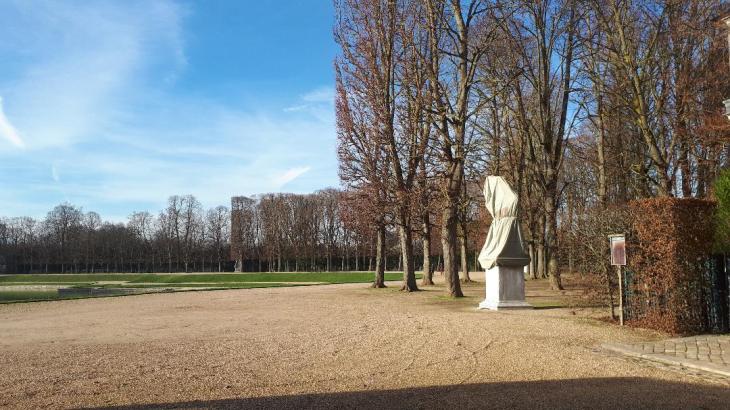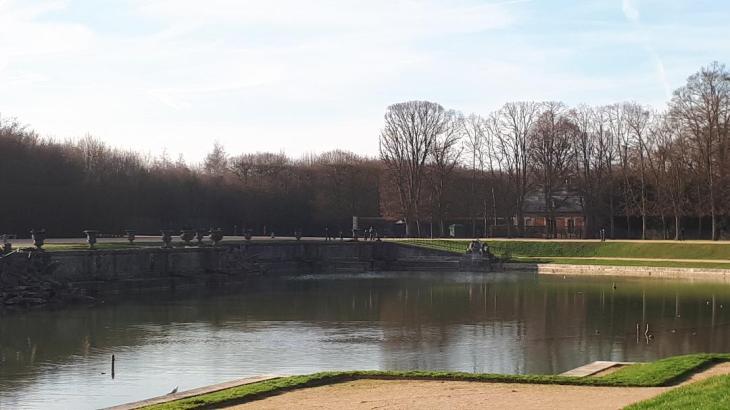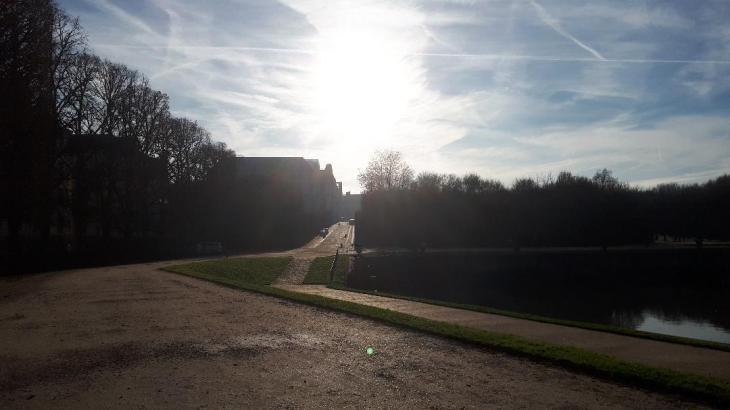I bring you back to something very familiar. I have written many posts in my blog about my previous glorious town of Versailles; the choices are a lot more than the palace, indeed , I need to say the Palace/museum of Versailles is worth a kingdom and many things to see that require more than two days to see it all . My nostalgic Versailles is the préfecture capital city of the department 78 Yvelines, in the Île de France region of my belle France.
I like to come back to tell you a bit more on an important element of the Domaine of Versailles, the Bassin de Neptune Basin. Hope you enjoy the post as I

The Neptune Basin is located in the Domaine which includes the Château de Versailles and named after Neptune. It lies in the alignment of the l’allée d’Eau and the bassin du Dragon, at the northern end of a south-north axis encompassing the pièce d’eau des Suisses, l’Orangerie , and the Parterres d’eau. Hint: it can be entered from the boulevard de la Reine and Rue des Reservoirs without going thru the main entrance if you have a prepaid ticket with less security just a cabin guard.

It was built between 1679 and 1681 under the direction of André Le Nôtre and then named pièce d’eau sous le Dragon (water part under the dragon) . During the reign of king Louis XV the basin was altered. The new basin then proposed important and varied water games that aroused the admiration of the court. The Neptune basin is composed of 33 fountains on two heights: 99 jets of water,22 fountains on a terrace on vases, 5 fountains of wall with statues of the kingdom of Neptune, 6 fountains on the lower body of water with 6 jets of 20 meters. Back of the grassed part, in the treed half-moon, there are three statues: Berenice, Faustine and La Renommée du Roi (fame of the King). The retaining wall is set up from 1678 to accommodate this expanse of water that marks the completion of king Louis XIV domaine. Below the water path that leads to the castle, the basin balances the pièce d’Eau des Suisses on the south side, near the Orangerie. It is Le Nôtre and then Hardouin-Mansart that give the Neptune basin its amphitheater form. This particular form, dictated by the very position of the basin, allows the spectator to make a complete turn and, thus, to change the viewpoint on the castle which is then offered to the gaze. This closes the perspective opened by the north-south axis. It is in 1684 that the 22 vases of lead with marine decorations made by many sculptors, and all more worked than the others, as well as the shells that form waterfalls of water, come to decorate the basin. They are distributed in relation to the central axis of the water room. Depending on the use, they are coated with a painting giving them the appearance of gilded bronze. In addition, 44 jets of water with a height of 21 meters still accentuate the size of the place. They are overhung by the Dragon’s water column, a height of 27 meters above the basin, towards the water aisle. The first watering of the Neptune Basin took place in 1685, under the satisfied gaze of king Louis XIV. The Neptune basin is considered a masterpiece of hydraulic gardens.

However, it is necessary to wait for the reign of king Louis XV so that the bassin de Neptune as we know it today is completed, with the setting up of sculpted decorations. These are the subjects of a real craze on the part of the artists of the time. In fact, in 1735, a competition was organized to find out who would make the sculpted decorations designed to decorate the basin. It is Lambert Sigisbert Adam who wins the prize and is responsible, under the direction of Gabriel, to realize the central group. He chose the theme of The Triumph of Neptune and Amphitrite. At the time, this masterpiece was the largest set of molten sculpture in lead. The group features the mighty god of the seas, Neptune, recognizable from his trident, and his wife Amphitrite, who receives a coral branch, on their maritime throne made up of a large shell of 7 meters ( aprox 23 feet) wide on 4 meters ( aprox 14 feet). The couple reigns over the mythological ocean that constitutes the basin. The angel playing the conch in front of the shell symbolizes their triumph. They are surrounded by nereids, tritons and dolphins. The two parts of the shell end in conch and are adorned with rock. The ensemble, marked by the movement, fits perfectly with the basin and its water games.

On either side of this central work, and in order to complete the ensemble, two groups were made at the same time: on the right, L’Océan and on the left Protée. The ocean god, the father of all the rivers and the master of the oceans, is spread over a sea unicorn in the midst of reeds and fish. On the front, a crab eats a snake. The god is represented all in volume and movement thanks to the work on the drape, thus showing the power of the Baroque art and the know-how of who made this sculpture in 1740. Protée, in 1739, is the son of the ocean. He is the keeper of marine animals, as the seals around him testify. The two dragons driven by the loves that meet at the bottom of the glacis of the water room. On 11 August 1741, the Neptune basin finally adorned with its sculptural attires was inaugurated. This basin remains today the highlight of the spectacle of the Grandes Eaux Musicales du Château de Versailles. It is the basin for which the water flow is the most important and the most impressive.
The official Château de Versailles on the Bassin de Neptune : https://www.chateauversailles.fr/decouvrir/domaine/les-jardins/les-bassins-les-fontaines#le-bassin-de-neptune
The official Château de Versailles on the Grandes Eaux Musicales or music gardens show :https://en.chateauversailles-spectacles.fr/programmation/the-musical-gardens-show_e2758
The magazine of the Château de Versailles :http://www.lescarnetsdeversailles.fr/category/patrimoine/
There you go folks, it is my favorite basin in the domaine and we have many souvenirs of walking and even playing with my boys on the right side of it coming from Blvd de la Reine. The Neptune basin is one of the hightlights of the gardens at the Domaine de Versailles. Again, hope you enjoy it as I
And remember, happy travels, good health, and many cheers to all !!!
